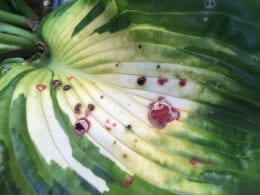By: Judy O’Mara
Hosta is a standard go to plant for every shade garden. They are very hardy and have few problems and you can plunk them in the ground and come back 20 years later and they will still be going strong. They really do have few problems…and yet, they aren’t problem free. Here are two things that I’ve seen on hosta this spring.
 Anthracnose on hosta will show up as brown scattered spots. The centers sometimes drop out creating a shot hole appearance. Like all fungal diseases, it has been favored by the wet conditions this spring.
Anthracnose on hosta will show up as brown scattered spots. The centers sometimes drop out creating a shot hole appearance. Like all fungal diseases, it has been favored by the wet conditions this spring.
The impact of anthracnose on the plant is cosmetic. The disease is fairly easily cleaned up by picking off the infected leaves.
Aside from rainy weather, prolonged leaf wetness from watering late in the day can also promote conditions that favor the disease. Switching to morning irrigation will allow the leaves to dry out quickly, which in turn reduces disease activity.
A bit more serious is Hosta virus X (aka HVX). This disease is sap transmitted. If you divide an infected plant and then use the same tools to divide a healthy plant, the virus can be spread to the new plant. Virus diseases tend to weaken the plant, so infected plants may end up smaller and less vigorous than healthy plants nearby. The best way to avoid the problem is to inspect hosta plants when purchasing them. If you discover a plant with Hosta virus X in your yard dig it up and discard it.
Hosta virus X is tricky to identify based on symptoms because it can look similar to normal hosta variegation. Confirmation of the disease is done in a lab with a serological test (ELISA). However… one symptom that I have seen consistently associated with Hosta virus X is called ‘ink vein bleeding’. This is where the veins of the leaf have the opposite color and appear to be bleeding like an ink blot.
Healthy Hosta Hosta with HVX


Iowa State University has a great publication on Hosta Diseases and Pests.
